Tropical houseplants are more than just decorative elements for your home – they’re a statement of lush beauty, air-purifying properties, and the calming touch of nature. Whether you’re an experienced gardener or a novice looking to add a touch of greenery to your space, tropical houseplants are the perfect way to enhance your indoor environment. In this complete guide, you’ll discover the best tropical plants, tips for care, and how to style them to suit any room in your house.
By the end of this article, you’ll be well-equipped to bring the tropical charm into your home with confidence. Let’s dive in!
What Are Tropical Houseplants?
Before diving into the different types of tropical plants you can grow in your home, it’s essential to understand what sets tropical houseplants apart from other types of indoor plants. Tropical houseplants are native to warm, humid climates found in regions like the rainforests of Central and South America, Southeast Asia, and parts of Africa. These plants have evolved to thrive in environments with consistently warm temperatures, high humidity, and indirect sunlight. Replicating these conditions at home is crucial for the health and longevity of your tropical plants.
Tropical houseplants are unique because they have adapted to life in dense, lush forests where sunlight is filtered through layers of trees and the air is naturally humid. Unlike plants native to arid environments, tropical houseplants are moisture-loving and need consistent watering and humidity to grow well.
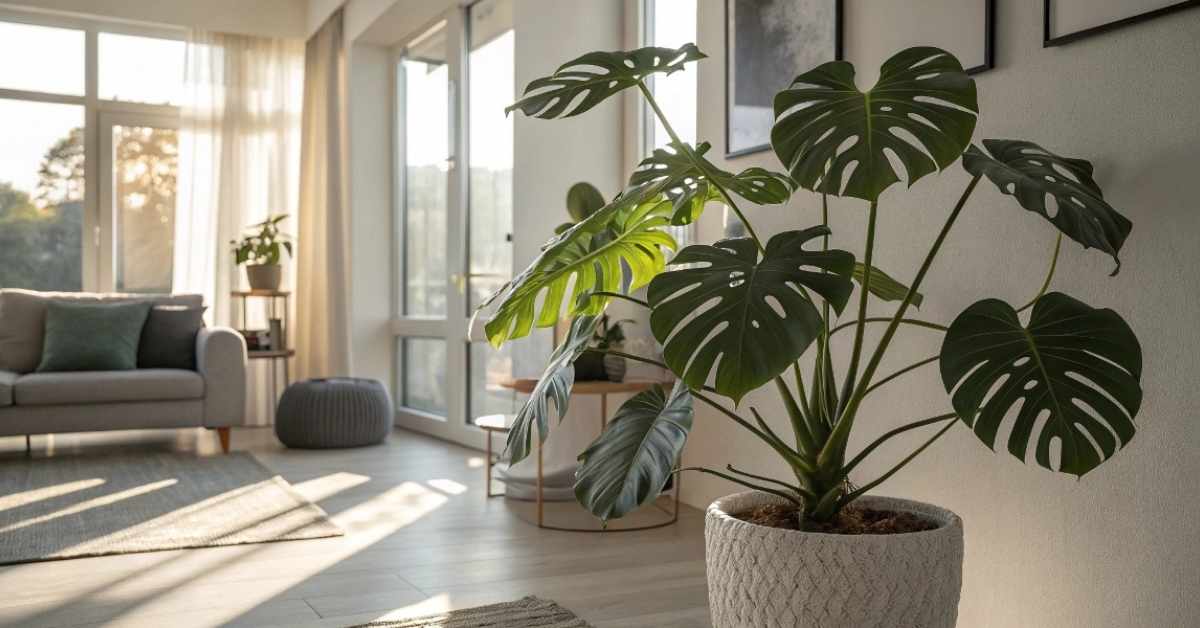
Key Characteristics of Tropical Plants:
- Large, Lush Leaves
One of the most recognizable features of tropical houseplants is their large, glossy leaves. These leaves are often broad and designed to capture as much sunlight as possible in environments with limited direct light. The size and texture of the leaves help the plant absorb sunlight efficiently, a necessity in the dense forests where they thrive. This characteristic makes tropical plants visually striking and perfect for adding an exotic touch to any room. - Moisture-loving
Tropical houseplants thrive in environments with high humidity and regular watering. They prefer moist soil but don’t like to sit in water, as this can lead to root rot. Mimicking the humid conditions of their native rainforests helps these plants thrive indoors. If you live in a dry area, it’s essential to create a humid environment around your tropical plants by misting them, using a humidifier, or placing them in naturally more humid rooms like bathrooms. - Vibrant Colors
Another standout feature of tropical houseplants is their vibrant and often dramatic foliage or blooms. Whether it’s the bold, patterned leaves of a Calathea or the brilliant flowers of a Bird of Paradise, tropical plants bring a pop of color and life to your home. This splash of color not only brightens up your space but also brings the energy and lushness of tropical climates right into your living room.
Understanding these key characteristics will guide you in creating the ideal environment for your tropical houseplants, ensuring they flourish in your home.
10 Popular Tropical Houseplants for Your Home
- When it comes to decorating your home with vibrant greenery, tropical houseplants are an excellent choice. These plants not only add a touch of the exotic to your indoor space but also bring numerous benefits, including purifying the air and improving your overall well-being. Here are 10 of the best tropical houseplants to grow in your home, each with its own unique features and care needs:
1. Monstera Deliciosa (Swiss Cheese Plant)
- The Monstera Deliciosa, often called the Swiss Cheese Plant due to its distinctive, split leaves, is one of the most iconic and popular tropical houseplants. Native to the rainforests of Central America, this plant thrives in bright, indirect light and is relatively easy to care for.
- Care Tip: Water your Monstera Deliciosa when the top 1-2 inches of soil feel dry. Overwatering can cause root rot, so ensure the soil is well-drained and allow it to dry out between waterings.
- Perfect for: Living rooms, offices, or any space where it has room to grow and spread. The Monstera can reach impressive sizes over time, making it a great statement plant.
2. Bird of Paradise (Strelitzia reginae)
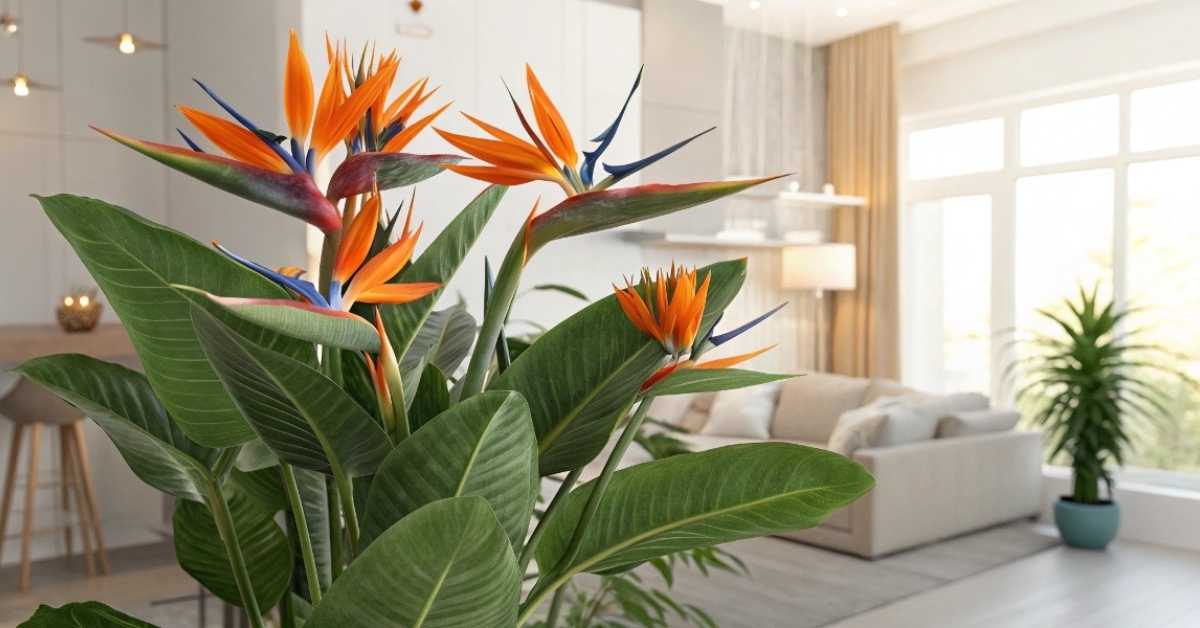
- Known for its striking, vibrant orange and blue flowers, the Bird of Paradise resembles the shape of a bird in flight, making it a stunning addition to any room. This plant requires bright, indirect light to thrive and needs regular watering to maintain its lush foliage.
- Care Tip: Keep the soil moist but not soggy, and be patient—this plant can take time to bloom. Don’t worry if it doesn’t flower immediately; it needs the right light and care to do so.
- Perfect for: Large spaces where it can make a dramatic statement. It’s ideal for living rooms or foyers where the plant can be showcased as a centerpiece.
3. Philodendron
- The Philodendron is an incredibly versatile plant that comes in many species and varieties, making it perfect for various indoor conditions. Known for its heart-shaped leaves and ease of care, it thrives in indirect light but can tolerate lower light conditions as well.
- Care Tip: Water the Philodendron when the soil feels dry to the touch but don’t let it stay too dry for extended periods. It’s crucial to provide consistent moisture for this plant, but avoid letting it sit in water.
- Perfect for: Hanging baskets, shelves, or trailing from high places. Its long, graceful vines look especially striking when allowed to drape down.
4. Areca Palm (Dypsis lutescens)
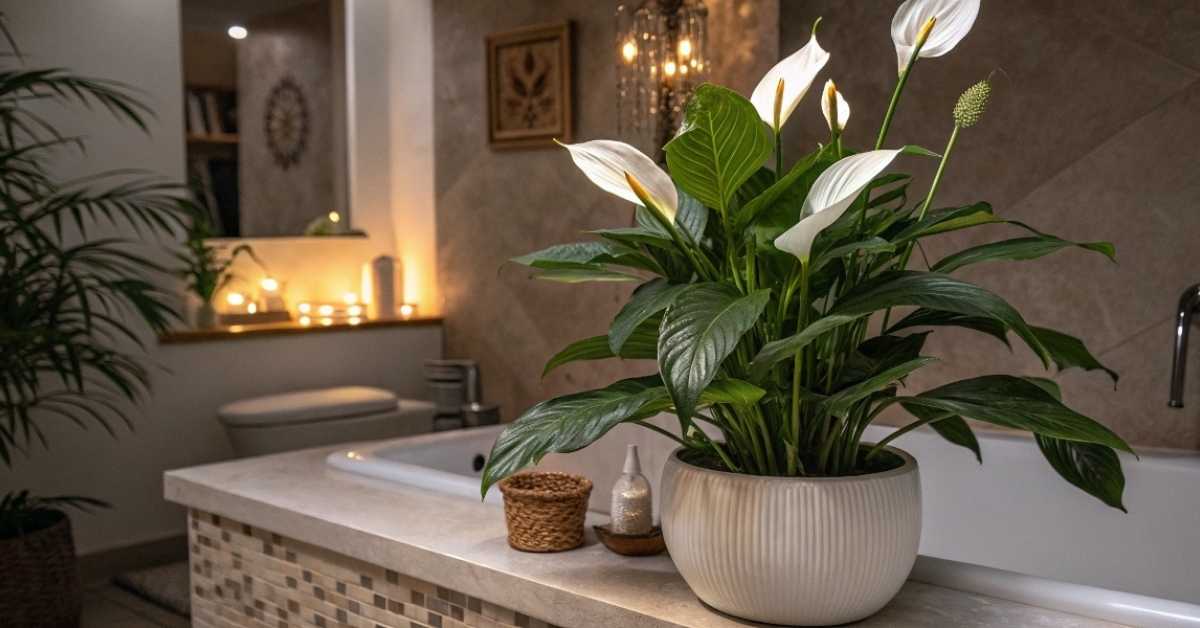
- The Areca Palm is one of the most popular indoor palms, known for its elegant, feathery fronds. This palm has exceptional air-purifying qualities, making it not only a beautiful addition to your home but also beneficial for your health. It prefers bright, indirect light and regular watering to keep it looking its best.
- Care Tip: To avoid browning tips, maintain a high humidity level around the plant, and ensure that the soil drains well. This palm doesn’t like to sit in stagnant water.
- Perfect for: Living rooms and hallways that need a touch of tropical elegance. It’s especially suitable for larger spaces where its full, bushy fronds can spread out.
5. Peace Lily (Spathiphyllum)
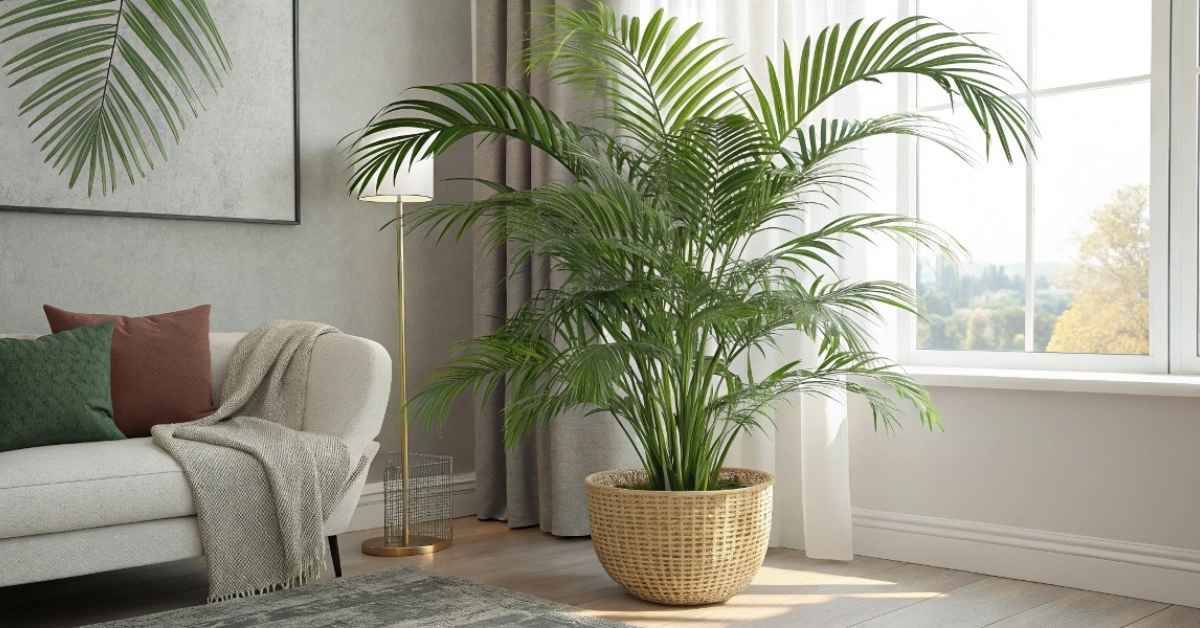
- The Peace Lily is one of the easiest tropical houseplants to care for, making it an excellent choice for beginners. Known for its beautiful white blooms and air-purifying qualities, this plant does well in low to medium light conditions and doesn’t need frequent watering.
- Care Tip: Keep the soil moist but avoid allowing it to become soggy. Peace Lilies are forgiving plants, so they’ll bounce back from a missed watering, but consistent moisture is key for healthy blooms.
- Perfect for: Bedrooms or bathrooms, where it thrives with minimal attention and provides the added bonus of improving air quality.
6. Snake Plant (Sansevieria)
- Although not technically a true tropical plant, the Snake Plant is often grouped with tropicals due to its tropical-looking leaves and its ability to thrive in low-light conditions. It’s an incredibly low-maintenance plant that can handle neglect and irregular watering, making it perfect for busy individuals or beginners.
- Care Tip: Allow the soil to dry out completely between waterings. Overwatering is one of the few things that can harm the Snake Plant, so it’s best to err on the side of dryness.
- Perfect for: Any room, especially spaces with low light conditions. Its upright, sword-like leaves make it a great choice for corners or narrow spaces.
7. Calathea
- Calathea plants are beloved for their stunning, patterned foliage, which often features intricate designs and vibrant colors. These plants thrive in medium to low light conditions and require high humidity to look their best, making them perfect for bathrooms or kitchens.
- Care Tip: Keep the soil consistently moist, but not waterlogged, and avoid placing your Calathea in drafty areas. This plant also prefers higher humidity, so misting or a humidifier may be beneficial.
- Perfect for: Bathrooms or kitchens, where humidity is naturally higher. Their colorful leaves make them a great conversation piece and a focal point in any space.
8. Pothos (Epipremnum aureum)
- Pothos is an incredibly hardy and adaptable plant, making it a perfect choice for beginners. This low-maintenance plant can thrive in a range of conditions, including low light, making it a great option for spaces where other plants may struggle.
- Care Tip: Let the soil dry out between waterings, as Pothos is quite forgiving and can tolerate neglect. This plant can also grow in water, making it a great option for propagation.
- Perfect for: Hanging baskets, shelves, or as a trailing plant in low-light areas. Its trailing vines make it especially beautiful when cascading from a high shelf or pot.
9. Fiddle Leaf Fig (Ficus lyrata)
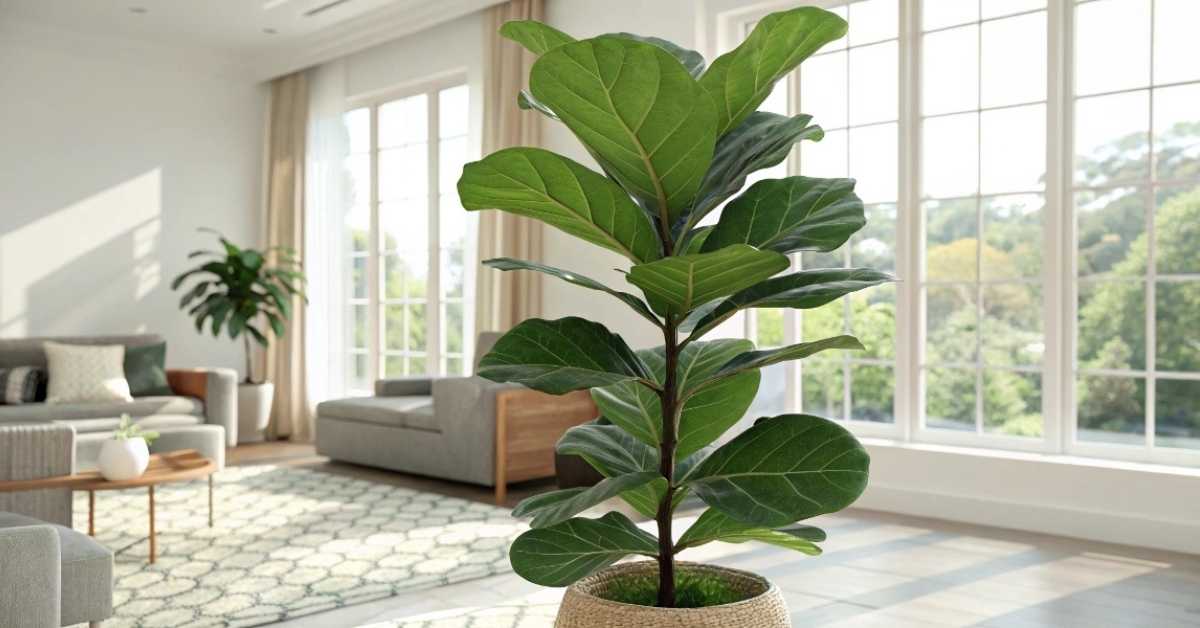
- The Fiddle Leaf Fig has become a trendsetter in interior design due to its large, sculptural leaves and striking appearance. While it’s perfect for making a statement, this plant does require more attention than some others on this list. It thrives in bright, indirect light and needs consistent watering.
- Care Tip: Provide plenty of bright, indirect light and avoid placing it in areas with fluctuating temperatures. It’s also essential to regularly clean the leaves to prevent dust buildup.
- Perfect for: Spacious living rooms or modern interiors where its large leaves can take center stage. It’s ideal for areas where it can receive the bright light it needs.
10. Bromeliad
- Bromeliads are known for their vibrant, exotic flowers that can last for months, making them a unique addition to your tropical plant collection. These plants do best in bright, indirect light and are relatively easy to care for. They prefer to be watered from the roots, as they typically have a central “cup” that holds water.
- Care Tip: Keep the central cup filled with water and ensure it’s getting plenty of indirect sunlight. Once the flowers fade, you can cut them back, and the plant may produce new pups (offspring) that can be replanted.
- Perfect for: Small spaces or adding a pop of color to your decor. Bromeliads do well in both homes and offices where they can be the focal point of a table or desk.
How to Care for Tropical Houseplants
Taking care of tropical plants requires understanding their unique needs. Here’s a breakdown of the most important aspects to consider:
Watering Tropical Houseplants
Tropical plants generally prefer consistent moisture, but not soaking wet roots. Water your plants when the top inch or two of soil feels dry to the touch. Be sure to use room temperature water to avoid shocking the roots.
- Pro Tip: Water thoroughly until the water runs out of the drainage holes, but don’t let the plant sit in water, as this can lead to root rot.
- For a guide on how to maintain healthy leaves, check out How to Clean Houseplant Leaves: Easy Methods. Additionally, tropical plants need good drainage to prevent waterlogging.
Temperature and Humidity
Tropical plants thrive in warm, humid conditions, similar to their native environments. Ideally, your indoor temperature should range from 65°F to 80°F, and humidity levels should be kept between 50-60%.
- Humidity Hacks: If you live in a dry area, consider using a humidifier or placing a tray of water near your plants. Alternatively, mist your plants lightly once or twice a week.
Lighting
Tropical plants require plenty of indirect light, as direct sunlight can scorch their leaves. South or east-facing windows are typically ideal for most tropical houseplants.
- Tip: If you don’t have ideal natural light, you can supplement with grow lights to ensure your plants get the light they need.
Fertilizing
Fertilizing is essential for tropical plants, as it supports their vigorous growth. Use a balanced, water-soluble fertilizer and apply it during the growing season (spring and summer). Avoid fertilizing in the winter when plant growth slows.
- Pro Tip: Over-fertilizing can harm plants, so stick to the recommended dosage.
Styling Your Home with Tropical Houseplants
Tropical plants can transform any room, adding a touch of the exotic and creating a natural ambiance. Here are some styling tips to make the most of your plants:
Create a Focal Point
Large plants like the Fiddle Leaf Fig or Bird of Paradise work well as a centerpiece in a room. Place them in corners or against a neutral wall to draw attention to their bold features.
Use Vertical Space
For smaller homes or apartments, use hanging baskets or wall-mounted planters to take advantage of vertical space. Plants like Pothos or Philodendrons are perfect for this style.
Combine with Furniture and Decor
Match the colors of your pots with your furniture to create a cohesive look. For example, pair a vibrant Calathea with bohemian-style furniture, or place a sleek Snake Plant in a modern, minimalist pot for a clean look.
Troubleshooting Common Tropical Plant Problems
Despite your best efforts, tropical plants may encounter a few issues. Here’s how to tackle the most common problems:
Overwatering and Root Rot
Overwatering is one of the most common mistakes with tropical plants. If your plant’s leaves are turning yellow or mushy, it may be a sign of root rot. Be sure to let the soil dry out between waterings and ensure proper drainage.
Pests and Diseases
Tropical plants can attract pests like spider mites, aphids, and mealybugs. Inspect your plants regularly for any signs of infestation and treat them with insecticidal soap or neem oil.
Yellowing Leaves
Yellow leaves are often a sign of poor watering practices, insufficient light, or nutrient deficiencies. Adjust your watering routine, move your plant to a brighter spot, or provide the appropriate fertilizer to help it recover. If you’re uncertain about which plants will thrive in specific lighting conditions, The Spruce offers a comprehensive guide to help you choose the best options. Check out their Plants A to Z for an extensive list of plant types and care tips.
Frequently Asked Questions
What are the best indoor plants for a tropical look?
If you’re aiming to create a tropical oasis indoors, there are several tropical houseplants that can help you achieve that lush, exotic look. Some of the best choices include:
- Monstera Deliciosa: Known for its dramatic, split leaves, this plant adds an iconic tropical vibe to any room.
- Bird of Paradise: With its large, bold foliage and stunning flowers, the Bird of Paradise brings vibrant color and tropical charm to any space.
- Areca Palm: The elegant, feathery fronds of the Areca Palm will instantly transport your indoor space to a tropical paradise.
- Calathea: Its intricate, patterned leaves offer a unique tropical aesthetic and are perfect for adding visual interest to your decor.
- Fiddle Leaf Fig: This plant’s sculptural leaves and size make it a standout feature in any modern, tropical-inspired room.
These tropical houseplants not only provide beauty and a tropical ambiance but also serve as air-purifying plants, enhancing your home’s air quality.
What is the easiest tropical plant to care for?
If you’re new to growing tropical houseplants, you’ll want to start with plants that are low-maintenance and forgiving. Some of the easiest tropical plants to care for include:
- Snake Plant (Sansevieria): Known for its toughness, the Snake Plant thrives in a variety of light conditions and requires little water, making it perfect for beginners.
- Pothos: This hardy, low-maintenance vine thrives in low light and only needs occasional watering. It’s incredibly easy to propagate as well.
- Peace Lily: While it loves moisture, the Peace Lily is very forgiving and can thrive in low light with minimal attention. It also tells you when it needs water by drooping.
- Philodendron: Known for its adaptability, the Philodendron can tolerate a range of light conditions and is fairly easy to maintain.
These tropical houseplants are perfect for those just starting out with indoor gardening or anyone who may not have a lot of time to dedicate to plant care.
What is the holy grail of houseplants?
The “holy grail” of houseplants can vary depending on personal taste and plant care preferences, but when it comes to tropical houseplants, many plant enthusiasts consider the Monstera Deliciosa to be the holy grail. Its large, split leaves and easy-care nature have made it a favorite among both beginner and experienced gardeners. The Monstera has gained iconic status due to its striking appearance and ability to thrive in various conditions, making it one of the most sought-after indoor plants.
Other plants that could be considered “holy grails” of indoor gardening include the Fiddle Leaf Fig, Bird of Paradise, and Calathea, all of which are highly prized for their beauty and air-purifying properties.
Are tropical plants good for indoors?
Yes, tropical houseplants are not only good for indoors, but they also thrive in indoor environments when their specific care needs are met. Most tropical plants prefer conditions that are common in indoor spaces, such as bright, indirect light and consistent humidity. In fact, many tropical plants are well-suited for growing indoors because they adapt well to lower light levels and warmer temperatures.
Tropical plants, such as the Peace Lily, Snake Plant, and Philodendron, can even help improve indoor air quality by filtering out toxins, creating a healthier living environment. These plants also contribute to the aesthetic appeal of your home, adding a lush, vibrant touch to your decor.
However, it’s important to remember that while tropical houseplants are well-suited for indoor growth, they do require certain care considerations like humidity, watering, and proper light. By providing the right conditions, you can enjoy thriving tropical plants indoors year-round.
Conclusion
Tropical houseplants are the perfect way to bring a touch of nature into your home. From vibrant foliage to air-purifying benefits, these plants offer more than just aesthetic appeal. By following the care tips and styling advice in this guide, you’ll be able to create an indoor oasis filled with lush, thriving tropical plants. Whether you’re looking for statement pieces like the Bird of Paradise or low-maintenance options like the Snake Plant, there’s a tropical houseplant for every space and skill level.
Remember, the key to success with tropical houseplants is consistency. With the right care, you can enjoy these stunning plants for years to come. Happy planting!

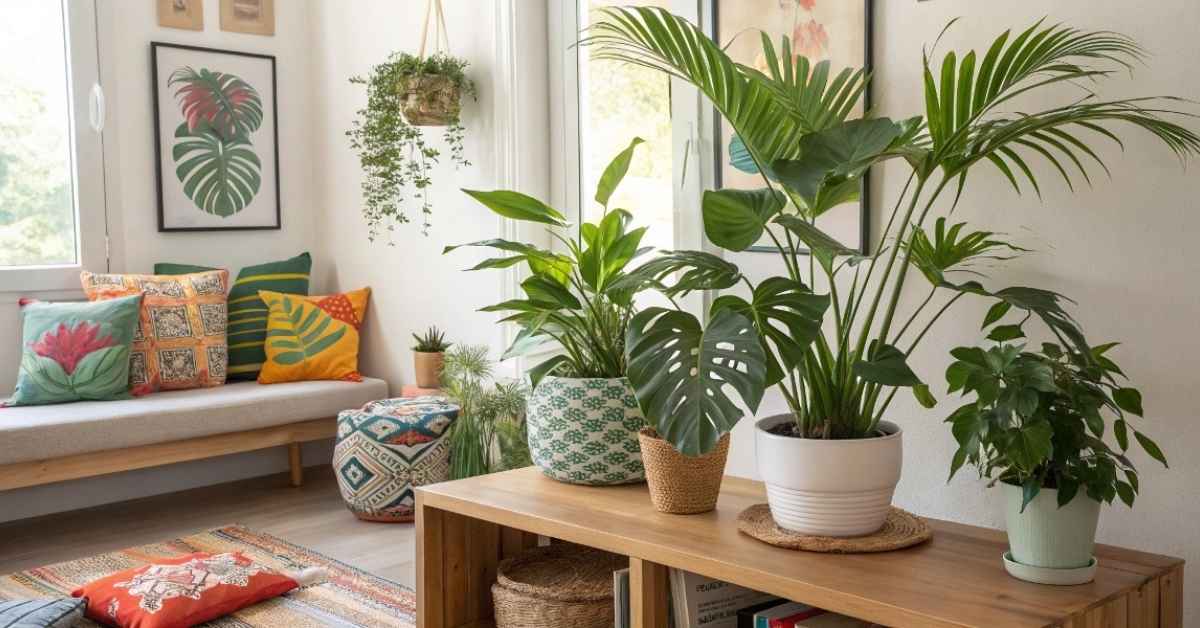

1 thought on “10 Tropical Houseplants You Can Grow in Your Home (Complete Guide)”